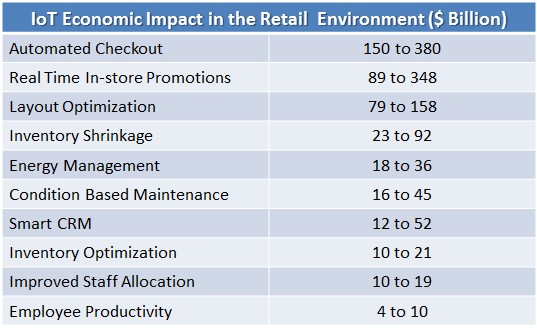
In the recently published McKinsey study "The Internet of Things (IoT): Mapping the Value Beyond the Hype", the retail industry is ranked fourth in highest potential next decade IoT economic impact.
McKinsey defines the retail environment broadly "as physical spaces where consumers engage in commerce—considering or purchasing goods or services. This includes traditional stores, such as department stores and grocery stores, as well as showrooms where goods are on display but not available for sale. It also includes physical spaces where services are purchased, such as bank branches, theaters, and sports arenas. The analysis covers only physical environments where IoT technologies can be deployed, not online retailing."
According to McKinsey, "retail environments have undergone significant change over the past two decades due to the introduction of information technologies, including the rise of online shopping. The Internet of Things has the potential to cause even greater disruption, but IoT can also provide traditional retailers with the tools to compete—and coexist—with the online retail world as “omni-channel” shopping erases the distinction between online and offline shops."
Future Internet of Things innovations have the potential to dramatically improve the onmi-channel retail customer experience. IoT "can guide the shopper to the item she has been looking at online when she enters the store and text her personalized coupons to make the purchase in-store that day. IoT technology can also provide data to optimize store layouts, enable fully automated checkout, and fine-tune inventory management. These and other innovations could enable new business models and allow retailers to improve productivity, reduce costs, and raise sales."
Internet of Things Retail Economic Impact
By 2025, for the retail industry, McKinsey estimates that IoT could have an economic impact of $410 billion to $1.2 trillion per year. By application, following is the IoT impact for the retail environment:

Consumer Technology Trends and IoT
Technology trends support the IoT retail evolution. In the USA, 55% of shoppers are using retailer specific mobile applications and 34% are using independent shopping apps such as Groupon and Zulily. "More than 40% of consumers want to receive their loyalty points/perks and discounts in real time, while shopping in the store, vs. receiving the same information in snail mail or in email."
By the numbers: 56% of smartphone users plan to use their devices while shopping; 85% of shoppers prefer personalized offers reflecting their past shopping behavior; 54% use or would like to use digital touchscreens in-store; and 61% would visit and do more shopping in a store with a beacon marketing campaign.
Welcome to the $1.2 Trillion Personal IoT Shopping Conversation
Mobile devices were the start of the IoT retail interactive shopping journey. Wearables and an increased focus on adding sensors inside the store (such as RFID) will accelerate the consumer connectivity trends. Big data and video analytics will clarify and add value to the personal shopping conversation.
Connectivity does not equate to success in retail. It is a starting point for a more in-depth conversation with the shopper. The data driven interaction will lead to faster decisions on store formats, brand value increases, improved product lifecycle management, and faster growth through globalization.
IoT will finally deliver customized shopping experiences. It's back to the future, where the shopkeeper will once more know your name. Technologically engage in the personal conversation for your share of the $1.2 trillion IoT retail opportunity.
















